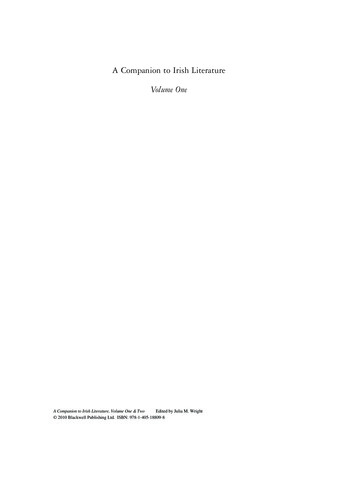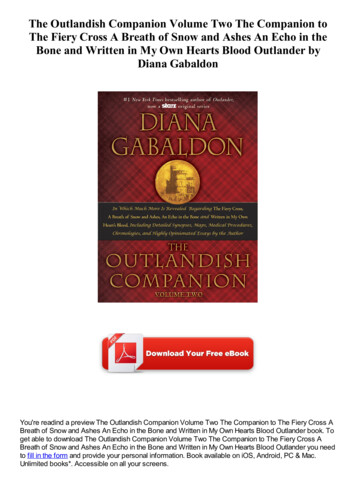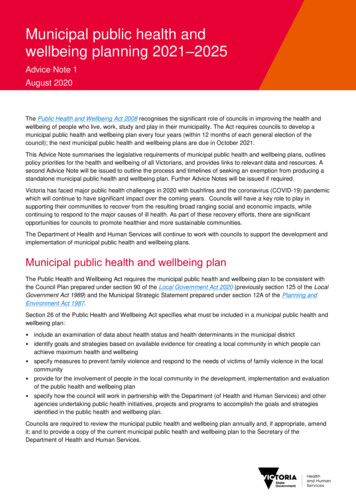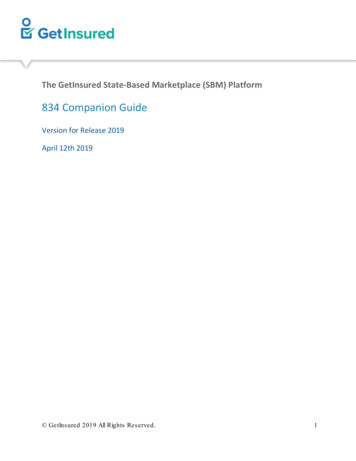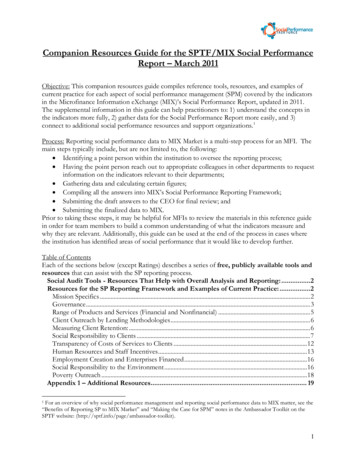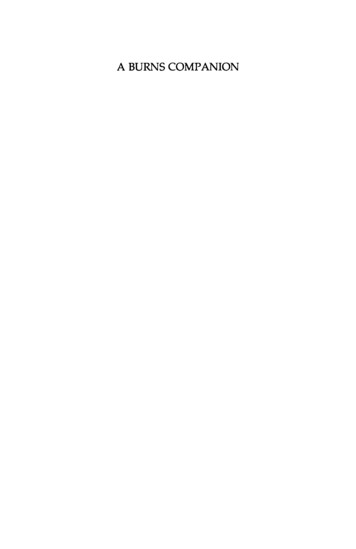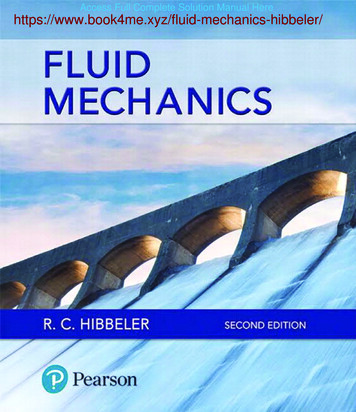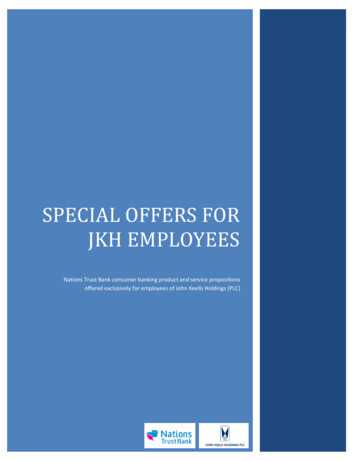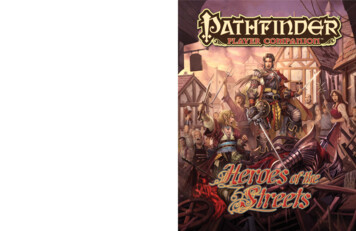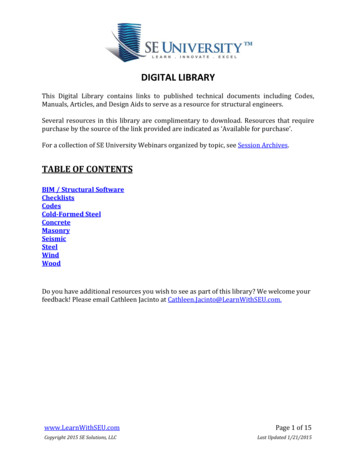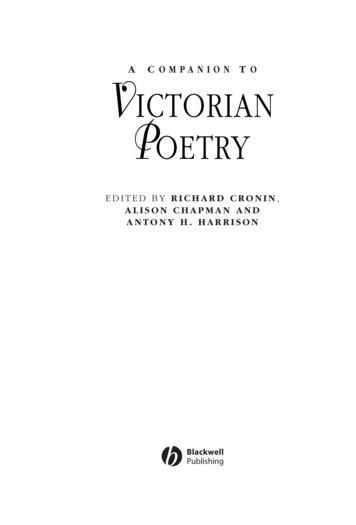
Transcription
AC OMPANION T OV ICTORIANP OETRYEDITED BY RICHARD CRONIN,ALISON CHAPMAN ANDANTONY H. HARRISON
A Companion to Victorian Poetry
Blackwell Companions to Literature and CultureThis series offers comprehensive, newly written surveys of key periods and movementsand certain major authors, in English literary culture and history. Extensive volumesprovide new perspectives and positions on contexts and on canonical and postcanonical texts, orientating the beginning student in new fields of study and providing the experienced undergraduate and new graduate with current and new directions,as pioneered and developed by leading scholars in the .AAAAAAAAAAAAAAACompanion to RomanticismCompanion to Victorian Literature and CultureCompanion to ShakespeareCompanion to the GothicFeminist Companion to ShakespeareCompanion to ChaucerCompanion to Literature from Milton to BlakeCompanion to English Renaissance Literature and CultureCompanion to MiltonCompanion to Twentieth-Century PoetryCompanion to Anglo-Saxon Literature and CultureCompanion to Restoration DramaCompanion to Early Modern Women’s WritingCompanion to Renaissance DramaCompanion to Victorian Poetry16. A Companion to the Victorian Novel17–20. A Companion to Shakespeare’s Works: Volumes I–IV21. A Companion to the Regional Literatures of America22. A Companion to Rhetoric and Rhetorical Criticism23. A Companion to the Literature and Culture of the American South24. A Companion to American Fiction 1780–186525. A Companion to American Fiction 1865–191426. A Companion to Digital Humanities27. A Companion to Romance28. A Companion to the British and Irish Novel 1945–200029. A Companion to Twentieth-Century American Drama30. A Companion to the Eighteenth-Century EnglishNovel and Culture31. A Companion to Old Norse-Icelandic Literature and Culture32. A Companion to Tragedy33. A Companion to Narrative Theory34. A Companion to Science Fiction35. A Companion to the Literatures of Colonial America36. A Companion to Shakespeare and Performance37. A Companion to Mark Twain38. A Companion to European Romanticism39. A Companion to Modernist Literature and Culture40. A Companion to Walt Whitman41. A Companion to Herman Melville42. A Companion to Medieval English Literatureand Culture c.1350 – c.150043. A Companion to Modern British and Irish Drama: 1880–200544. A Companion to Eighteenth-Century Poetry45. A Companion to Shakespeare’s Sonnets46. A Companion to Satire47. A Companion to William FaulknerEdited by Duncan WuEdited by Herbert F. TuckerEdited by David Scott KastanEdited by David PunterEdited by Dympna CallagbanEdited by Peter BrownEdited by David WomersleyEdited by Michael HattawayEdited by Thomas N. CornsEdited by Neil RobertsEdited by Phillip Pulsiano and Elaine TrebarneEdited by Susan J. OwenEdited by Anita PachecoEdited by Arthur F. KinneyEdited by Richard Cronin, Alison Chapman, and AntonyH. HarrisonEdited by Patrick Brantlinger and William B. ThesingEdited by Richard Dutton and Jean E. HowardEdited by Charles L. CrowEdited by Walter Jost and Wendy OlmstedEdited by Richard Gray and Owen RobinsonEdited by Shirley SamuelsEdited by Robert Paul Lamb and G. R. ThompsonEdited by Susan Schreibman, Ray Siemens, and John UnsworthEdited by Corinne SaundersEdited by Brian W. ShafferEdited by David ybyPaula R. Backscheider and Catherine IngrassiaRory McTurkRebecca BushnellJames Phelan and Peter J. RabinowitzDavid SeedSusan Castillo and Ivy SchweitzerBarbara Hodgdon and W. B. WorthenPeter Messent and Louis J. BuddMichael K. FerberDavid Bradshaw and Kevin J. H. DettmarDonald D. KummingsWyn bybyPeter BrownMary LuckhurstChristine GerrardMichael SchoenfeldtRuben QuinteroRichard C. Moreland
AC OMPANION T OV ICTORIANP OETRYEDITED BY RICHARD CRONIN,ALISON CHAPMAN ANDANTONY H. HARRISON
2002 by Blackwell Publishers Ltda Blackwell Publishing company350 Main Street, Malden, MA 02148-5018, USA9600 Garsington Road, Oxford, OX4 2DQ, UK550 Swanston Street, Carlton, Victoria 3053, AustraliaKurfürstendamm 57, 10707 Berlin, GermanyThe right of Richard Cronin, Alison Chapman and Antony H. Harrison to be identified as theAuthors of the Editorial Material in this Work has been asserted in accordance with the UKCopyright, Designs, and Patents Act 1988.All rights reserved. No part of this publication may be reproduced, stored in a retrieval system,or transmitted, in any form or by any means, electronic, mechanical, photocopying, recording orotherwise, except as permitted by the UK Copyright, Designs, and Patents Act 1988, withoutthe prior permission of the publisher.First published 2002 by Blackwell Publishers LtdFirst published in paperback 2007 by Blackwell Publishers Ltd12007Library of Congress Cataloging-in-Publication Data has been applied for.ISBN 978-0-631-22207-1 (hardback: alk. paper)ISBN 978-1-4051-7612-5 (paperback: alk. paper)A catalogue record for this title is available from the British Library.Set in 101/2/121/2 pt Garamond 3by SNP Best-set Typesetter Ltd., Hong KongPrinted and bound in the United Kingdomby TJ International Ltd., Padstow, Cornwall.The publisher's policy is to use permanent paper from mills that operate a sustainable forestrypolicy, and which has been manufactured from pulp processed using acid-free and elementaryChlorine-free practices. Furthermore, the publisher ensures that the text paper and cover boardused have met acceptable environmental accreditation standards.For further information onBlackwell Publishing, visit our website:http://www.blackwellpublishing.com
ContentsEditors’ PrefaceNotes on ContributorsChronologyIntroduction: Victorian PoeticsCarol T. ChristPART ONE1Varieties and Formsviiixxv123EpicHerbert F. Tucker252 Domestic and IdyllicLinda H. Peterson423 LyricMatthew Rowlinson594 Dramatic MonologueE. Warwick Slinn805 Sonnet and Sonnet SequenceAlison Chapman996 ElegySeamus Perry1157 HymnJ. R. Watson134
viContents8 NonsenseRoderick McGillis1559 Verse NovelDino Felluga17110 Verse DramaAdrienne Scullion18711 Working-Class PoetryFlorence Boos20412 The Classical TraditionRichard Jenkyns22913 Arthurian Poetry and MedievalismAntony H. Harrison24614 Poetry in TranslationJ.-A. George26215 Tractarian PoetryStephen Prickett27916 The SpasmodicsRichard Cronin29117 The Pre-Raphaelite SchoolDavid Riede30518 The Poetry of the 1890sChris Snodgrass321PART TWO343Production, Distribution and Reception19 The MarketLee Erickson34520 Anthologies and the Making of the Poetic CanonNatalie M. Houston36121 ReviewingJoanne Shattock378
Contentsvii22 Poetry and IllustrationLorraine Janzen Kooistra392PART THREE419Victorian Poetry and Victorian Culture23 Nationhood and EmpireMargaret Linley42124 Poetry in the Four NationsMatthew Campbell43825 Poetry and ReligionW. David Shaw45726 Poetry and ScienceAlan Rauch47527 Landscape and CityscapePauline Fletcher49328 Vision and VisualityCatherine Maxwell51029 Marriage and GenderJulia F. Saville52630 Sexuality and LoveJohn Maynard543Index567
Editors’ PrefaceIn England, the period from about 1830 until World War I is normally distinguished byhistorians as ‘Victorian’ in honour of the longest-reigning monarch in British history, whodominated the era as a kind of cultural icon. These years witnessed an extraordinary flowering of literary culture, comparable in many respects to what occurred under England’sother long-lived and remarkably influential female monarch, Queen Elizabeth I. Despitethe virtual absence of significant drama produced for the stage during most of the Victorian era, every other genre flourished. (Much great dramatic literature did in fact emerge,but not in the form of stage plays.) The productivity of poets, novelists and writers ofself-consciously artistic prose non-fiction remains, from the vantage of the early twentyfirst century, breathtaking.The work of the poets, on whom this volume focuses, retains its ability to enchant,amaze and inspire. Victorian poetry, as a vast and extraordinarily complex body of productions, employs every established verse form in the language and exploits every established poetic subgenre, while refining upon some, such as the dramatic monologue, theverse drama and the pastoral elegy, in ways previously unimagined. Produced by authorsof both sexes in every social class from all districts in the British Isles (and indeed thecolonies), it engages a remarkable variety of cultural discourses – political, religious, social,economic and scientific – in both direct and nuanced ways that still strike readers as highlyoriginal, and also aesthetically and ideologically powerful. Coming to critical terms withthis diverse body of materials is a project that in itself raises many critical and theoretical issues, issues that the editors of this Companion have attempted to address openly inboth the content of its chapters and its organizing principles.Readers of this volume will immediately notice its differences from some of the otherBlackwell Companions, as well from other works that attempt in some way to present acritical or historical introduction to Victorian poetry. Instead of collecting essays that treatsignificant Victorian poets or poems individually, we have brought together specially commissioned chapters that reflect both the multifariousness of Victorian poetry and thevariety of critical approaches to it – many of them richly informed by recent developments in textual and cultural theory. Thus, rather than presenting a single chapter onIdylls of the King, we provide readers with a number of chapters in which Tennyson’s great
Editors’ Prefaceixepic is discussed, along with other significant Victorian poems, in terms of genre (Tucker),marketing (Erickson) and reception (Shattock), but also within a variety of cultural contexts, such as Victorian medievalism (Harrison), Victorian concerns with nationhood andempire (Linley), and Victorian attitudes to gender (Saville) and sexuality (Maynard). Adetailed topical index allows readers to trace such connections. This volume is thusdesigned, at one level, to demonstrate the ways in which a given poet or poem can beseen to emerge from a number of cultural matrices and participate in a variety of culturaldiscourses. At another, it seeks to explore the relationships – generic, stylistic, thematic– between work by different poets, and in doing so resuscitate a considerable body ofpoetry of the period that has fallen into neglect.In her introduction on Victorian poetics, Carol T. Christ offers a commanding overviewof the whole period. The remaining contributions are organized in three parts: ‘Varietiesand Forms’, ‘Production, Distribution and Reception’ and ‘Victorian Poetry and Victorian Culture’. Part one surveys the generic range of Victorian poetry and the variety of itsschools and styles. In part two the focus shifts from the form and content of Victorianpoetry to the means of its production. Chapters deal with issues ranging from the newprint technologies and the economics of the production of poetry to the structure of themarketplace, and to the influence of anthologies, lending libraries, illustration and reviewing on the reception of Victorian poets and their work. Part three attempts to positionVictorian verse in what the editors see as crucial cultural contexts and to explore the interactions between the poetry and dominant cultural discourses.This book offers itself as a companion to a body of work most of which had almost disappeared from view in the mid-twentieth century, and much of which has still to attractthe attention that it deserves. In the 1960s Victorian poetry had been all but reduced tothe work of three poets: Alfred Tennyson, Robert Browning and Matthew Arnold. GeraldManley Hopkins and Thomas Hardy remained, but by virtue of being enrolled as modernsbefore their time. The work of Victorian women poets had been effectively erased. Muchhas changed since then, and this Companion reflects that. But it seeks to do still more: tolay out an agenda for the study of Victorian poetry in coming years. It suggests, forexample, that the work of women poets no longer needs special defence. It is treated herenot in one chapter but in every chapter. This Companion maps areas that invite futureresearch, in chapters such as Florence Boos’s on Victorian working-class poetry, and itrecalls to attention poems that remain unread, as in Herbert F. Tucker’s chapter on theVictorian epic. In place of the tastefully minimalist shop window that the New Critics ofthe last century displayed to their readers, this Companion to Victorian Poetry offers a windowthat is richly and chaotically cluttered. But there is an appropriateness in that: Victorianshops after all had windows of precisely that kind.
Notes on ContributorsFlorence Boos, a professor of English at the University of Iowa, has published booklength studies of the poetry of Dante Gabriel Rossetti and William Morris, and editedMorris’s Socialist Diary and Earthly Paradise, as well as a more recent special issue ofVictorian Poetry devoted to nineteenth-century working-class poetry. She is currently atwork on a book on working-class women poets of Victorian Scotland.Matthew Campbell is Senior Lecturer in English Literature at the University of Sheffield.He is the author of Rhythm and Will in Victorian Poetry (1999) and co-editor of Beyond thePleasure Dome: Writing and Addiction from the Romantics (1994) and Memory and Memorials,1798–1914: Literary and Cultural Perspectives (2000). He is currently working on Irishpoetry in the Union, 1801–1921, and editing The Cambridge Companion to ContemporaryIrish Poetry. He is editor of the Tennyson Research Bulletin.Alison Chapman is a lecturer in English Literature at the University of Victoria, Canada.She is the author of The Afterlife of Christina Rossetti (2000). She is editing a collection ofessays on Victorian women poets for the series Essays and Studies (2003) and, with JaneStabler, co-editing Unfolding the South: Nineteenth-Century British Women Writers and Artistsin Italy (2002) and a special issue of Forum (2003) on Anglo-American expatriate communities in Italy.Carol T. Christ is Professor of English at the University of California at Berkeley anduntil recently was Vice-Chancellor and Provost of that university. Her books include TheFiner Optic: The Aesthetic of Particularity in Victorian Poetry (1975), Victorian and ModernPoetics (1984) and Victorian Literature and the Victorian Visual Imagination (1995), and shehas edited The Mill on the Floss.Richard Cronin is Professor of English Literature at the University of Glasgow. His booksinclude Shelley’s Poetic Thoughts (1981), Colour and Experience in Nineteenth-Century Poetry(1988), Imagining India (1989), 1798: The Year of the Lyrical Ballads (1998), The Politics ofRomantic Poetry: In Search of the Pure Commonwealth (2000) and Romantic Victorians (2002).
Notes on ContributorsxiLee Erickson, Professor of English at Marshall University, is the author of RobertBrowning: His Poetry and His Audiences (1984) and The Economy of Literary Form: EnglishLiterature and the Industrialization of Publishing, 1800–1850 (1996).Dino Felluga is an assistant professor at Purdue University, West Lafayette, where heteaches nineteenth-century British poetry as well as theory and cultural studies. Articlesof his have appeared in SEL: Studies in English Literature, Criticism, European Romantic Reviewand ARIEL. He is currently completing his first book, entitled The Perversity of Poetry: TheMarket, Romantic Ideology, and the Masculine Poet.Pauline Fletcher is a professor of English at Bucknell University and general editor ofthe Bucknell Review. Her publications include the monograph Gardens and Grim Ravines:The Language of Landscape in Victorian Poetry (1983) and, edited together with John Murray,Wordsworth in Context (1992), as well as numerous essays on Victorian poetry.J.-A. George is a graduate of Vassar College and King’s College, London. She has taughtin the Irish Republic and currently lectures at the University of Dundee, where she alsoruns the Mediaeval Drama Group. She has published on Old and Middle English language and literature, sixteenth-century drama, the Pre-Raphaelites and translation theory.Antony H. Harrison is Professor of English at North Carolina State University. He hasedited The Letters of Christina Rossetti (4 vols), Gender and Discourse in Victorian Literatureand Art and The Culture of Christina Rossetti. His authored books include Victorian Poetsand the Politics of Culture: Discourse and Ideology (1998), Victorian Poets and Romantic Poems:Intertextuality and Ideology (1990), Christina Rossetti in Context (1988) and Swinburne’sMedievalism: A Study in Victorian Love Poetry (1988). He has held fellowships from theNational Endowment for the Humanities, the National Humanities Center and theAmerican Council of Learned Societies. He is currently writing Matters of Taste: VictorianPoetry and Desire.Natalie M. Houston is an assistant professor at the University of Houston. She has published articles on Victorian women writers, nineteenth-century sonnet anthologies and thepoetry of the Crimean War. She is currently completing a book on the cultural history ofthe Victorian sonnet.Richard Jenkyns is a Fellow of Lady Margaret Hall and Professor of the Classical Tradition at the University of Oxford. His books include The Victorians and Ancient Greece (1980),Three Classical Poets (1982), Classical Epic: Homer and Virgil (1991), The Legacy of Rome(1992), Dignity and Decadence: Victorian Art and the Classical Inheritance (1992) and Virgil’sExperience (1998).Lorraine Janzen Kooistra, Associate Professor of English at Nipissing University inNorth Bay, Canada, has published numerous articles on visual/verbal relations and
xiiNotes on ContributorsVictorian poetry. She is co-editor, along with Mary Arseneau and Antony H. Harrison, ofThe Culture of Christina Rossetti: Female Poetics and Victorian Contexts (1999) and author ofThe Artist as Critic: Bitextuality in Fin-de-Siècle Illustrated Books (1995) and Christina Rossetti and Illustration: A Publishing History (2002).Margaret Linley is an assistant professor of English and member of the Print Culture1700–1900 Specialized MA at SFU. She has published on literary annuals, Tennyson,Christina Rossetti, Felicia Hemans and Letitia Landon. She is currently working on a bookon Victorian poetry, the British nation and imperialism.Catherine Maxwell is Senior Lecturer in English in the School of English and Drama atQueen Mary, University of London. She is the editor of the Everyman edition AlgernonCharles Swinburne (1997) and The Female Sublime from Milton to Swinburne: Bearing Blindness (2001). She has published essays and articles on Christina and D. G. Rossetti, Browning, George Eliot, Shelley, Ruskin, Swinburne and Vernon Lee, and is currently writingthe volume on Swinburne for the series Writers and their Work.John Maynard is Professor of English at New York University, where he served as Chairfrom 1983 to 1989. He has published Charlotte Brontë and Sexuality (1983) and VictorianDiscourses on Sexuality and Religion (1993) as well as two studies of Robert Browning. Heis co-editor of Victorian Literature and Culture. He is currently working on a project onreader theory.Roderick McGillis is a professor of English at the University of Calgary. He is the authorof The Nimble Reader (1996), A Little Princess: Gender and Empire (1996) and Children’s Literature and the Fin de Siècle (2001). He has recently published his first novel. His currentwork deals with the construction of masculinity in popular culture.Seamus Perry is Reader in English Literature at the University of Glasgow and authorof Coleridge and the Uses of Division (1999), editor of Coleridge: Interviews and Recollections(2000), and co-editor, with Nicola Trott, of 1800: The New Lyrical Ballads (2001). He isan editor of the journal Essays in Criticism.Linda H. Peterson is Professor of English at Yale University. She has recently publishedTraditions of Victorian Women’s Autobiography: The Poetics and Politics of Life Writing (1999),as well as articles on Tennyson, Letitia Landon, Barrett Browning, Christina Rossetti,Margaret Oliphant and Mary Cholmondeley.Stephen Prickett is Regius Professor of English Language and Literature at the University of Glasgow. His books include Coleridge and Wordsworth: The Poetry of Growth (1970),Romanticism and Religion: The Tradition of Coleridge and Wordsworth in the Victorian Church(1976), Victorian Fantasy (1982), Words and the Word: Language, Poetics and BiblicalInterpretation (1986) and Origins of Narrative: The Romantic Appropriation of the Bible (1996).
Notes on ContributorsxiiiAlan Rauch, Associate Professor of Literature, Communication, and Culture at theGeorgia Institute of Technology, researches the cultural studies of science in the nineteenth century. He is the author of Useful Knowledge: The Victorians, Morality, and the Marchof Intellect (2001). His current projects include Private Reading: Public Knowledge, whichfocuses on nineteenth-century private subscription libraries and their role in the dissemination of knowledge, as well as a reprint of William Paley’s Natural Theology. Rauch hasalso edited Jane Loudon’s 1827 novel The Mummy! A Tale of the Twenty-Second Century(1994) and, with George Levine, One Culture: Essays in Science and Literature (1987).David Riede is Professor of English at Ohio State University. He is the author ofSwinburne: A Study of Romantic Mythmaking (1978), Dante Gabriel Rossetti and the Limits ofVictorian Vision (1983), Matthew Arnold and the Betrayal of Language (1988), Oracles andHierophants: Constructions of Romantic Authority (1992) and Dante Gabriel Rossetti Revisited(1992).Matthew Rowlinson teaches English at the University of Western Ontario. He is theauthor of Tennyson’s Fixations: Psychoanalysis and the Topics of the Early Poetry (1994) andnumerous articles on Victorian Literature. His current research links literary allegory andthe history of money forms in nineteenth-century Britain.Julia F. Saville is Associate Professor of English at the University of Illinois at UrbanaChampaign, specializing in Victorian poetry and the relation between nineteenth-centurypoetics and the visual arts. She is the author of A Queer Chivalry: The Homoerotic Asceticismof Gerard Manley Hopkins (2000) and various essays. Currently she is working on a bookprovisionally entitled Bathing Boys: An Aesthetics of the Male Nude in Victorian Literature andCulture.Adrienne Scullion teaches in the Department of Theatre, Film and Television Studies atthe University of Glasgow. Her publications on Scottish cultural issues include articles inthe journals Comparative Drama, New Theatre Quarterly and Theatre Research International,and essays in the collections Group Identities on French and British Television (2001), TheCambridge Companion to Modern British Women Playwrights (2000) and A History of ScottishWomen’s Writing (1997). She also works on early women playwrights and is the editor ofFemale Playwrights of the Nineteenth Century (1996).Joanne Shattock is Professor of Victorian Literature and Director of the Victorian StudiesCentre, University of Leicester. She is editor of The Cambridge Bibliography of EnglishLiterature, third edition, vol. 4, 1800–1900 (1999), and has recently published Women andLiterature 1800–1900 (2001). She co-edits a monograph series, The Nineteenth Century, forAshgate.
xivNotes on ContributorsW. David Shaw is Professor of English at the University of Toronto. Amongst his booksare The Dialectical Temper: The Rhetorical Art of Robert Browning (1968), Tennyson’s Style(1976), The Lucid Veil: Poetic Truth in the Victorian Age (1987), Victorians and Mystery: Crisesof Representation (1990), Elegy and Paradox: Testing the Conventions (1994) and Origins of theMonologue: The Hidden God (1999).E. Warwick Slinn is Associate Professor of English at Massey University, New Zealand.He has studied in Canada and England and has been a Fulbright Scholar at the University of Virginia and Duke University. He has written essays on literary theory as well aspoetry and is the author of Browning and the Fictions of Identity (1982) and The Discourse ofSelf in Victorian Poetry (1991). He is currently completing a book on Victorian poetry ascultural critique.Chris Snodgrass has published numerous articles on figures such as Carlyle, Swinburne,Wilde, Dowson, Symons and Beardsley, among others. He is the author of Aubrey Beardsley, Dandy of the Grotesque (1995) and is currently writing a second book on Beardsley andfin-de-siècle sexuality.Herbert F. Tucker has published Browning’s Beginnings: The Art of Disclosure (1980) andTennyson and the Doom of Romanticism (1988), edited the Blackwell Companion to VictorianLiterature and Culture (1999), and co-edited with Dorothy Mermin a teaching anthologyof poetry and prose, Victorian Literature 1830–1900 (2002). Recent articles discuss the epicpoetry of Barrett Browning, Tennyson, Browning, Swinburne and Morris; recent auguriesportend completion of The Proof of Epic in Britain 1790–1910. At the University ofVirginia he serves as associate editor of New Literary History and series editor in VictorianLiterature and Culture for the University Press.J. R. Watson is Emeritus Professor of English Literature at the University of Durham.His books include Picturesque Landscape and English Romantic Poetry (1970), Browning’s Menand Women and Other Poems: A Casebook (1974), Everyman’s Book of Victorian Verse (1982),Wordsworth’s Vital Soul: The Sacred and Profane in Wordsworth’s Poetry (1982), English Poetryof the Romantic Period, 1789–1830 (1985), The Poetry of Gerard Manley Hopkins: A CriticalStudy (1987) and The English Hymn: A Critical and Historical Study (1997).
ChronologyDate1827182818291830Poetry volumesJohn Keble, Christian YearRobert Pollok, The Course of TimeAlfred Tennyson, Poems by Two BrothersJohn Clare, The Shepherd’s CalendarL. E. L., The Golden VioletFelicia Hemans, The Records of WomanOther literary and artistic eventsFirst publication of The Keepsake,instituting vogue for annualsL. E. L., The Venetian BraceletEbenezer Elliott, The Village PatriarchTennyson, Poems, Chiefly LyricalHemans, Songs of the Affections1831Elliott, Corn Law RhymesArthur Hallam, ‘On Some of theCharacteristics of Modern Poetry’1832Tennyson, Poems (dated 1833)Penny Magazine1833Elizabeth Barrett, Prometheus BoundRobert Browning, PaulineStart of Oxford Movement and theTracts for the Times (1833–41)Thomas Carlyle, Sartor ResartusJohn Stuart Mill, ‘What is Poetry’and ‘Two Kinds of Poetry’ContextsFirst Reform Bill introduced toParliament and rejected by Houseof LordsRiots in Bristol, Derby andNottinghamThomas Arnold appointedheadmaster, RugbyCatholic EmancipationMetropolitan Police ActCharles Lyell, Principles of GeologyRailways beginGeorge III dies; William IVbecomes kingDiscovery of chloroformDiscovery of electromagnetic currentFirst cholera epidemicFirst Reform BillHarriet Martineau, Illustrations ofPolitical Economy (1832–4)Babbage’s Difference Engine No. 1constructedAbolition of slavery in British Empire
Date Poetry volumes1834Henry Taylor, Philip van ArteveldeBenjamin Disraeli, The RevolutionaryEpickHallam, Remains18351836Browning, ParacelsusClare, The Rural MuseWilliam Wordsworth, Yarrow Revisitedand Other PoemsEliza Cook, Lays of a Wild HarpL. E. L., The Vow of the PeacockJoanna Baillie, Dramas1837Browning, Strafford1838Barrett, The Seraphim and Other PoemsCook, Melaia, and Other Poems1839Philip Bailey, FestusL. E. L., The Zenana and Other Poems1840Browning, SordelloRichard Barham, Ingoldsby LegendsCaroline Norton, The Dream and OtherPoems1841Browning, Pippa PassesOther literary and artisticeventsDavid Friedrich Strauss, Leben Jesu(Life of Jesus)Charles Dickens, Pickwick Papers,beginsAugustus Pugin, ContrastsCarlyle, The French RevolutionDickens, Oliver Twist, beginsDickens, Nicholas Nickleby, beginsMary Shelley’s edition of PercyBysshe Shelley’s Poetical WorksCarlyle, ChartismPunch begins publicationContextsWilliam Henry FoxTalbot produces photographsDeath of Samuel Taylor ColeridgePoor Law Amendment Act(‘New Poor Law’)John Elliotson, Human PhysiologyAccession of Queen VictoriaStereoscopy inventedPeople’s Charter published (May)Anti-Corn Law League (1838–46)Chartist riotsDaguerreotyping process announcedin FrancePenny post introduced byRowland HillStereotyping beginsVictoria marries AlbertC. H. Townshend, Facts in Mesmerism
Date Poetry volumesOther literary and artisticeventsContexts1842Browning, Dramatic LyricsTennyson, PoemsThomas Macaulay, Lays of Ancient RomeJohn Westland Marston, GeraldChartist riotsCopyright BillIncome Tax introduced1843R. H. Horne, Orion1844Barrett, PoemsCoventry Patmore, PoemsWilliam Barnes, Poems of Rural Life inthe Dorset Dialect (1844–62)Browning, Dramatic Romances andLyricsThomas Cooper, The Purgatory ofSuicidesPoems by Currer, Ellis and Acton BellEdward Lear, A Book of NonsenseMudie’s Circulating LibraryestablishedJ. M. W. Turner, Steamboat in aSnowstormFirst issue of Illustrated London NewsMacaulay, Critical and Historical EssaysCarlyle, Past and PresentWordsworth poet laureateTurner, Approach to VeniceJohn Ruskin, Modern Painters, beginsDickens, Martin Chuzzlewit, beginsDickens, A Christmas CarolHorne, A New Spirit of the AgeChambers, Vestiges of Natural CreationTalbot, The Pencil of Nature (1844–6)Disraeli, SybilIrish Famine (1845–51)John Henry Newman converts toCatholicismMarriage of Elizabeth Barrett andRobert BrowningGeorge Eliot, translation of Strauss’sLife of JesusDickens, Pictures from ItalyEmily Brontë, Wuthering HeightsCharlotte Brontë, Jane EyreWilliam Thackeray, Vanity FairRepeal of t
13. A Companion to Early Modern Women’s Writing Edited by Anita Pacheco 14. A Companion to Renaissance Drama Edited by Arthur F. Kinney 15. A Companion to Victorian Poetry Edited by Richard Cronin, Alison Chapman, and Antony H. Harrison 16. A Companion to the Victorian Novel Ed
